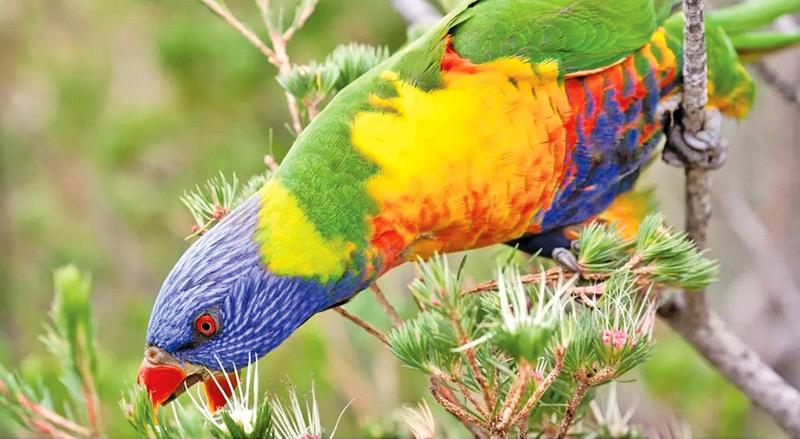
In the 1980s, there were no rainbow lorikeets in Canberra; now they’re one of the city’s most-sighted birds. But they’re not the only successful urban adaptor
My bird-watching friend Simon is telling me about the parrots he sees on his daily walks around Canberra. It is a long list, which includes five types of cockatoos. When he gets to the tenth parrot species – “red-rumps. Everyone loves those” – he stops to think. The eleventh is the rainbow lorikeet.
“They’re newcomers,” he says. “And they’ve really taken off.”
I find it difficult to imagine a city without rainbow lorikeets. I am in far north Queensland and they are everywhere. Street trees are filled with shrieking, whistling birds. Flocks fly past in tight formation. Everything about them is frantic – from their nectar-guzzling to their psychedelic plumage.
According to BirdLife Australia’s annual Aussie Backyard Bird Count, the rainbow lorikeet is the most abundant species in the eastern states. Every year since the count began in 2014, the bird has been ranked No 1 one nationwide. But in Canberra, the species is a recent arrival. It is making up for lost time.
Canberra’s Lake Burley Griffin, where native plants have made homes for rainbow lorikeets. Photograph: Rohan Thomson/Getty Images
Neil Hermes, a freelance ornithologist and the president of the Canberra Ornithology Group (Cog), has been keeping an eye on bird populations in the national capital. Long-term data collected by the Cog show lorikeet numbers rocketing.
“In the 1980s, there were no rainbow lorikeets in Canberra,” Hermes tells me. “Now they’re one of the most common birds.”
When small numbers of rainbow lorikeets first appeared in the city, they were thought to have been aviary escapers. Cage birds might have contributed, but, Hermes says, it is highly likely that Canberra’s population grew from individuals who wandered west from the coast and found the city’s parks and gardens to their liking.
Canberra’s extensive plantings of native trees and shrubs offer plenty of food and nesting sites. The Molonglo River, lakes Burley Griffin and Ginninderra, and the creeks, ponds and wetlands around the city provide a reliable water supply.
“Rainbow Lorikeets are good at adapting to urban habitat and Canberra has created a large amount of new habitat,” Hermes says.
“It is a fabulous city for birds. Conditions are perfect for them.”
The lorikeets’ association with inland towns is made strikingly obvious by maps of sightings from the Australian Capital Territory and adjacent areas. The largest numbers are from Canberra and neighbouring Queanbeyan, followed by Yass and Goulburn, with a few records for small rural towns like Bungendore. Sightings are almost absent from the surrounding country. Decades of data show that the birds prefer to settle in built up areas.
A female eastern koel – a migratory bird that is becoming more common in Australia’s eastern cities. Photograph: Ken Griffiths/Getty Images/iStockphoto
Advertisement
While other species suffer from the impact of urban encroachment, rainbow lorikeets belong to a small group that thrives around humans. These “urban adapters” include Australian magpies, magpie-larks, crested pigeons, noisy miners, and even eastern koels.
Koels are turning up in Canberra in rapidly increasing numbers, paralleling the lorikeets’ pattern of none, to some, to many. Flying in from New Guinea and Indonesia, these migratory cuckoos arrive in spring to breed in northern and eastern Australia.
The birds are difficult to spot – males are glossy black, and the females are mosaics of brown and cream – but they are easy to hear. The male’s insistent ko-el ko-el ko-el is now part of the city’s nocturnal soundscape. It might be a blessing for Canberra’s birdwatchers, but not for those species in whose nests koels lay their eggs – or for light sleepers.
While some urban adapters are only reclaiming their natural ranges, rainbow lorikeets and eastern koels are extending theirs into fresh territory.
Another butterfly, the tawny coster from Asia, was first recorded in Australia in 2012. Since then, it has spread across the tropics and, in the past year or so, northern New South Wales. The tawny coster has not had to rely on parks and gardens; its principal food plant, the delicate blue spade flower (pigea enneaspermus), is native to the warmer parts of the country.
- Guardian.com
